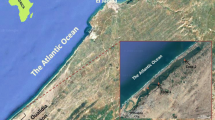Abstract
Nuclides liberated by explosion and subsequent fire at Chernobyl No. 4 reactor on 26 April 1986, travelled to Western Europe with lower tropospheric air masses1. They reached the northern Alps2 and Paris3 on 30 April, southern Great Britain4 on 2 May, the southern North Sea5 on 3 May, and the northern North Sea1 on 3 May and again on 8 May. Levels of deposited activity varied by a factor of 30 or more over distances < 100 km because of variability of rainfall2,6. A sediment trap deployed 222-m-deep in the North Sea off Bergen recorded the onset and magnitude of the deposition of Chernobyl nuclides. The trap collected 13 samples between 24 April and 21 September 1986. The flux of nuclides adsorbed to particles sinking from surface waters to sediments started less than ten days after contaminated air reached the site. Maximum specific activity occurred on 16–27 May for 137Cs, 134Cs, 106Ru and 103Ru, and on 8–20 June for 144Ce, 95Nb and 95Zr. The highest activity was found for 103Ru. The highest total specific activity of these nuclides in depositing sediments reached 670,000 Bq kg−1, and the highest total activity flux for one day amounted to 50 Bq m−2.
Similar content being viewed by others
References
Smith, F. B. & Clark, M. J. Nature 322, 690–691 (1986).
Hohenemser, C. et al. Nature 321, 817 (1986).
Thomas, A. J. & Martin, J. M. Nature 321, 817–819 (1986).
Pringle, D. M., Vermeer, W. J. & Allen, K. W. Nature 321, 569 (1986).
Deutsches Hydrographisches Institut. Die Auswirkungen des Kernkraftwerkes von Tscher-nobyl auf Nord- und Ostsee. Meeresk. Beob. Ergebn. Dt. Hydrogr. Inst. 62, (1987).
Geyh, M. A., Hennig, G., Kruck, W. et al. Bimdesforschungsanstalt f. Landeskunde und Raumordnung 1987 (1/2) (1987).
Honjo, S., Connel, J. F. & Sachs, P. L. Deep-Sea Res. 27, 745–754 (1980).
Gesellschaft für Reaktorsicherheit. Neuere Erkenntnisse zum Unfall im Kemkrafiwerk Tscher-nobvl, GRS-S-40, 2nd edn., 74 pp. (1987).
Backhaus, J. O. Estimates of the Variability of Low Frequency Currents and Flushing-times of the North Sea. Vol. C24 (International Council for the Exploration of the Sea, 1984).
Kautsky, H. Deut. Hydrogr. Zeitschr. 40, 49–69 (1987).
Review of the Continued Suitability of the Dumping Site for Radioactive Waste in the North-East Atlantic (Nuclear Energy Agency, Paris, 1985).
Author information
Authors and Affiliations
Rights and permissions
About this article
Cite this article
Kempe, S., Nies, H. Chernobyl nuclide record from a North Sea sediment trap. Nature 329, 828–831 (1987). https://doi.org/10.1038/329828a0
Received:
Accepted:
Issue Date:
DOI: https://doi.org/10.1038/329828a0
- Springer Nature Limited
This article is cited by
-
Sediment fluxes and the littoral drift along northeast Andhra Pradesh Coast, India: estimation by remote sensing
Environmental Monitoring and Assessment (2013)
-
Nutrients and organic compounds in the North Sea (Concentrations, Dynamics and Methods): a review
Senckenbergiana maritima (2004)
-
Measurements of the suspended matter settling velocity in the German Bight (North Sea)
Deutsche Hydrographische Zeitschrift (1995)
-
Levels of natural and artifical radioactivity in sediments in the Eastern Black Sea of Turkey
Journal of Radioanalytical and Nuclear Chemistry Letters (1995)
-
Sedimentation and distribution of gamma-emitting radionuclides in bottom sediments of southern Lake P�ij�nne, Finland, after the Chernobyl accident
Hydrobiologia (1991)





